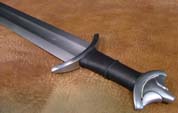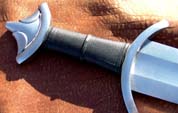|
|

The
Thegn
Limited
Edition Anglo-Saxon Sword
(Anglo-Saxon sword,
Hilt type L)Thegn
or Thane, is an Anglo-Saxon title (Anglo-Saxon:
žeg(e)n, Danish: degn, Old High German: degan, Old Norse: thegn or "king's
follower") meaning an attendant, servant,
retainer or official, usually in a military sense similar to the later
"knight."
The Anglo-Saxon Dictionary describes a thegn as "one engaged
in a king's or a queen's service, whether in the household or in the country,"
and adds, "the word in this case seems gradually to acquire a technical
meaning, and to become a term denoting a class, containing, however, several
degrees." The nobility of Anglo-Saxon England was ranked according to
the heriot (basically a "death tax") they paid in the
following descending order: earl, king's thegn, median
thegn. In Anglo-Saxon hierarchic society, a king's thegn attended
in person upon the king, bringing with him his men and resources. A "median"
thegn did not hold his land directly from the king but through an
intermediary lord. The thegn was inferior to the aethel
(a member of a king's family) but he was superior to the ceorl (a
freeman of the lowest class). It is interesting to note that this status
could be earned, not solely inherited. A document believed to be from
the time of Alfred the Great states:
And if a ceorl throve, so that he had fully five hides*
of his own land, church and kitchen, bellhouse and burh-gate-seat, and
special duty in the king's hail, then was he thenceforth of thegn-right
worthy.
(*A hide of land was sufficient to support one family
for a year.)
A successful thegn might also hope to become an earl. The highest
level thegn, a king's thegn, was a person of great importance
with special privileges, as contemporary manuscripts illustrate by the
Latin translation of the word thegn as comes (a title comparable
to "count" in later times). No one save the king had the right
of jurisdiction over a King's thegn.
After the Norman Conquest, the existing thegns appear to have been
absorbed into the emerging class of Knight. The Domesday Book,
compiled after the Norman Conquest, still listed the thegns who
held lands directly from the king with their respective counties, but
the title became devalued over time, partly because there were so many
thegns. The title of thane was still used in Scotland as
late as the 15th century to describe an hereditary nonmilitary tenant
of the crown, and appears in this use in Shakespeare's famous play, Macbeth
(the Thane of Cawdor.)
A Classic Anglo-Saxon Sword
Our Thegn is a tribute to those early military leaders and the
sword represents one classic style of distinctively Anglo-Saxon sword
hilts.
The curved upper and lower guards of this sword and the three lobed pommel
with the prominent middle peak are typical features for Anglo-Saxon swords
of this period. The type is also found in Scandinavia and Petersen dates
these type L swords to the second half of the 9th C in his study of Norwegian
Viking swords.
The two side lobes on the pommel may on some swords show clear signs of
being stylized beast heads, while on others the simplification has progressed
so that the lobes are just saddle shaped semicircles.
The upper and lower guards are usually thinner than those found on other
contemporary swords. They tend to be deeper across instead, like a broad
boat shape when seen from the blade.
Another typical feature is the short grip. On most originals this is around
3.31" (8.4 cm) or less. A short hilt combines with the curving guards
to a surprisingly secure and comfortable grip.
The Thegn has slightly slimmer dimensions than the other swords
in this line. The blade is still broad at the base and the fuller is wide
and well defined. This makes for a sword with quick handling characteristics.
The unique pommel, with its two saddle-shaped side lobes, are accented
with a twisted strand of sterling silver wire on each side.
The blade is hand-ground from high-carbon steel to a fine satin finish,
heat-treated by hand for maximum flexibility and to take a fine edge.
These swords are sold sharp, unless otherwise requested by the customer.
A Limited Edition
Hand Crafted Collectible Sword
This Anglo-Saxon
sword is offered in a limited edition of only 500 collectible swords
worldwide.
Specifications
Overall length: 34.5" (87.6 cm)
Blade Length: 28.75" (73 cm)
Blade width: 2.1875" (5.6 cm)
CoB: 5.5" (14 cm)
CoP: 18.25" (46.36 cm)
Weight: 2 lbs (915 grams)
You can customize your sword's grip color -- see
the standard grip colors here.
The Thegn (Anglo-Saxon)...
$1,111
Order now
before this limited edition collectible sword runs out!
|






